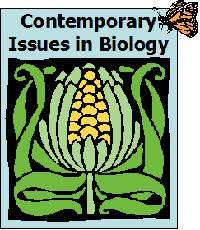
Week 5, Chapter 5 -- Digging Deeper Sample Answer
Course home | Weekly schedule | Announcements | Instructor Info | Desire2Learn | MasteringBiology® | Honor Code | FAQs | HELP!
 |
Week 5, Chapter 5 -- Digging Deeper Sample AnswerCourse home | Weekly schedule | Announcements | Instructor Info | Desire2Learn | MasteringBiology® | Honor Code | FAQs | HELP! |
It wouldn't be New Orleans without Mardi Gras, and it wouldn't be Mardi Gras without the Mardi Gras Indians. Every year, African-American residents from the inner city of New Orleans don beaded suits and elaborate headdresses, transforming themselves into the Mardi Gras Indians (1). Tribes of Mardi Gras Indians parade through New Orleans, displaying their elaborate costumes to one another. The Mardi Gras Indian Tradition dates back to before World War I. Racism prevented New Orleans' African-American population from participating in many Mardi Gras traditions. So they created their own tradition. Their costumes and dancing are inspired by Native American dress and are meant to honor Native Americans that helped runaway slaves.
Ironically, the same segregated environment that fostered the development of this unique cultural phenomenon might also lead to its demise. New Orleans is located between Lake Pontchartrain and the Gulf of Mexico (2). Most of the city lies below sea level. A system of dikes and levees keeps water from Lake Pontchartrain and the Gulf of Mexico from flooding the city. The city of New Orleans has been likened to a bowl. Giant pumps are required to move any water that makes its way into the "bowl" out into the Gulf of Mexico or Lake Pontchartrain. Many of New Orleans' African American residents, including the Mardi Gras Indians, live in neighborhoods far below sea level, the areas that are most vulnerable to flooding.
Global temperatures are increasing and as temperatures increase, sea levels are also expected to rise (3). Rising sea levels could be disastrous to New Orleans. Eventually the dike and levee system will not be able to hold back the Gulf of Mexico and New Orleans, beginning with the neighborhoods inhabited by the Mardi Gras Indians, will be lost. An increase in temperature is also predicted to lead to more severe weather patterns, including hurricanes. Hurricanes pose a severe threat to New Orleans, as was demonstrated last year by Hurricane Katrina (4). After Hurricane Katrina struck New Orleans, many of the Mardi Gras Indians were forced to evacuate the city. Many of the Indians evacuated during the hurricane lack the financial means to return. The reality of global warming means that sea level rise and violent hurricanes like Katrina will be more common. These natural disasters could force the Indians to permanently leave their homes.
The increase in global temperature, or global warming, is caused by an increase in carbon dioxide in the atmosphere (5). Carbon dioxide traps heat radiated from the earth that would normally be lost to space, resulting in an increase in temperatures. Carbon dioxide has always been present in the atmosphere, but since pre-industrial times the level of carbon dioxide in the atmosphere has increased by 31%. This increase in carbon dioxide is leading to higher temperatures than would naturally occur. The source of this carbon dioxide is the burning of fossil fuels, including oil and gas. Ironically, a quarter of US oil and gas production takes place in and around New Orleans (2).
However, not everyone is convinced that humans are behind the increase in global temperatures or that future warming will be significant (6). Our understanding about future temperatures is based on climate models. Climate models predict future temperatures based on past and present conditions. Some researchers are skeptical about the accuracy of the predictions made by climate models because of problems with the data used to build the models. Although this is a legitimate concern for any model, Tom Wigley of the National Center for Atmospheric Research says, "A fantastic amount of work has gone into trying to correct for all of these so-called [problems]."(6)
If humans are indeed behind the change in climate, what can the average citizen do about it? Experts say that the average citizen can reduce emission of carbon dioxide by using public transportation and by buying fuel efficient cars (5). In addition, citizens can support legislation that requires reductions in greenhouse gas emissions by industries and requires automobile makers to produce more fuel-efficient cars.
After Hurricane Katrina, the future of the Mardi Gras Indians and even the city of New Orleans was in question. But in March 2006, during the first Mardi Gras after the hurricane, the Mardi Gras Indians returned to the streets of New Orleans (4). Although the size of their tribes had diminished, the tradition had survived the storm. Let's all do our part to reduce carbon dioxide emissions so that the tradition of the Mardi Gras Indians can continue.
(1) Mardi Gras New Orleans. 2002. Mardi Gras Indians: Tradition and History. http://www.mardigrasindians.com/index.html. Downloaded July 21, 2006.
(2) Louisiana State University Hurricane Center. 10/08/2004. The Philadelphia Inquirer: New Orleans' Growing Danger by Paul Nussbaum. http://hurricane.lsu.edu/_in_the_news/phillyinquirer100804.htm. Downloaded July 21, 2006.
(3) National Resources Defense Council. 01/09/2006. The Consequences of Global Warming. http://www.nrdc.org/globalWarming/fcons.asp. Downloaded July 21, 2006.
(4) NOLA.com. 03/01/2006. The Times-Picayune: Indian tradition marches on in devastated neighborhoods by Trymaine Lee. http://nola.live.advance.net/mardigras/t-p/index.ssf?/base/carnival-0/114119724917810.xml. Downloaded July 21, 2006.
(5) Union of Concerned Scientists. 01/18/2006. Global Warming FAQ. http://www.ucsusa.org/global_warming/science/global-warming-faq.html. Downloaded July 21, 2006.
(6) PBS and WGBH/NOVA/Frontline. 04/2000. What's Up With the Weather: The Debate. http://www.pbs.org/wgbh/warming/. Downloaded July 21, 2006.
[Back to Digging Deeper Assignment]
[sample assignment by Matt Chumchal]